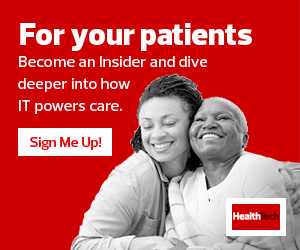As the position evolves, CXOs are taking on more responsibility. Today’s CXO must expand beyond the patient to include customers, or people who haven’t yet interacted with a healthcare organization but may have a desire to do so. Edwards explains that the CXO also has to focus on how to attract new patients.
Mullings-Smith says that CXOs must also consider patients’ experiences with all hospital staff as well as third-party vendors and partners, not just clinicians. However, a clinician’s impact on the overall patient experience remains highly influential. If the clinician experience is positive and engaging, then they are more likely to have a positive impact on patient care and experiences.
“We can build the best patient experience strategy, but if I haven’t touched on the caregiver side of things then that strategy will fall flat, even with the best intentions,” says Mullings-Smith.
Edwards adds that in the past, CXOs tried to manage patient and clinician experiences in “well-intended silos,” not fully understanding that it’s the workforce that provides the experience.
“We had to stop presenting patient experience as a checked box of tasks to do. It isn’t a thing we do, but a reality and environment we create for everyone,” she explains. “How can we make life easier for our caregivers to seamlessly ease the way of patients? We have to start with caregivers.”
The CXO should create forums and other mediums for capturing clinicians’ voices, she adds, and integrate their input into decision-making that can identify the best opportunities for increasing positive clinician experiences and wellness. Mullings-Smith recommends choosing solutions that satisfy multiple needs at once and that provide a downstream effect for other staff members.
EXPLORE: Why human experience is the future of healthcare.
CXOs Respond to Patients’ Demands for Digital-First Healthcare
Digital-first technologies such as telehealth not only provide convenience for patients who don’t want to attend in-person appointments but also increase access to underserved communities and patients who have difficulty taking time off.
As UChicago Medicine’s CXO, Mullings-Smith says she wants patients to truly embrace the technology and understand what’s available to them.
“It should be as easy as dialing it up on your smartphone,” she says. “It’s a great way for us to chip away at those health disparities — which is a core mission at UChicago Medicine — but it’s not enough to just say it’s available. We have to make it easy.”
In response to these shifts in the health IT landscape, Mullings-Smith says the CXO must create strong partnerships with the chief digital transformation officer to evaluate the ease and access of technology offerings and see those as another entry point to the healthcare system.
The idea of digital being an additional entry point for patients is important to Edwards, who says there is no single door for patients. Digital is one of many ways patients can access healthcare today. Edwards explains that while Providence has fully embraced digital technologies and recognizes that their adoption will grow, the CXO has to approach the patient experience in an omnichannel way.
However, digital tools can help engage consumers who are not yet patients and give them meaningful information for their health and well-being. Offering online scheduling and appointments outside of normal business hours can convert consumers to patients. It’s also important to help patients navigate their personal healthcare journey by illuminating their next step, such as scheduling a mammogram or flu shot.
LEARN MORE: Find out how to build patient trust with access to digital-first healthcare.
Common Technologies Used by CXOs to Improve Patient Experiences
Patients interface with technology throughout their healthcare journey. Healthcare organizations may offer online scheduling, the ability for a patient to check in for an appointment as soon as they step on the campus using geofencing, the ability to make hospital meal choices on an iPad device versus waiting in a queue on the phone, or telemedicine for post-procedure follow-up visits.
“The public is expecting greater convenience in healthcare. While we’re not Amazon, and no one expects us to be, they do expect us to adopt technology to make the overall healthcare journey a bit more convenient and easier to navigate,” says Mullings-Smith. “Technology can allow us to do that by improving the access and entry points to our system, as well as overall navigation.”
Technology can also assist in the physical navigation of hospital campuses. Wayfinding apps and AI-powered wheelchairs make it easier for patients to get around. Mullings-Smith recommends CXOs keep these needs in mind when organizations are building new care facilities.
More healthcare organizations are turning to customer relationship management platforms to get insight into patient demographics, which can help the CXO create a targeted and personalized experience for patients.
Providence is also looking to use its current technology, such as electronic health records and patient portals, differently. Edwards explains that post-intervention surveys are a lagging indicator of a patient’s experience, but EHRs, patient portals and other solutions have the potential to give the organization real-time feedback throughout the entire journey.
DISCOVER: How to balance patient and provider experiences in the continuum of care.
The CXO’s Role in Protecting Patient Data
As patients and healthcare organizations adopt health IT solutions, organizations have a greater responsibility to make sure security is up to date and at the forefront of the digital experience, according to Mullings-Smith. She says the CXO must work with the chief digital transformation officer and information security team to make sure patient experience improvements don’t come at the expense of security.
Edwards says the patient experience plan at Providence protects physical and mental well-being in addition to patient data.
“We’re careful about protecting data in such a way that those who don’t need access to patient data don’t have access,” she says.
It’s also important to engage with patients and the community to hear their concerns about security and data privacy. Mullings-Smith points out that prioritizing security during technology implementations may mean that healthcare organizations move more slowly compared with the consumer market.
“We don’t want to rush through things until we’re as sure as we can be about the security of patient information,” she says.
The Future of the CXO in Healthcare
Edwards anticipates changes in how the patient experience will be measured in the future. She explains that 30 years ago, access, care coordination and safety were the categories most important to patients, and those haven’t changed.
“What that tells me is that it’s not necessarily that the patients want something net new. Either we’ve failed to respond to that despite our best efforts, or we’ve been measuring patient experience the wrong way all this time,” Edwards says. “I expect to see a shift in how we measure patient experience that goes beyond government regulatory requirements. Those are important and a mainstay, but how do we graduate from that?”
As their role evolves, Mullings-Smith expects CXOs to get a seat at the table in the healthcare leadership structure and be more involved in decision-making. She says including the CXO in those conversations will automatically ensure the patient’s voice is heard. Without the CXO’s involvement, the patient’s unique perspective may be left out of critical decisions about technology implementation and the design of new facilities.













